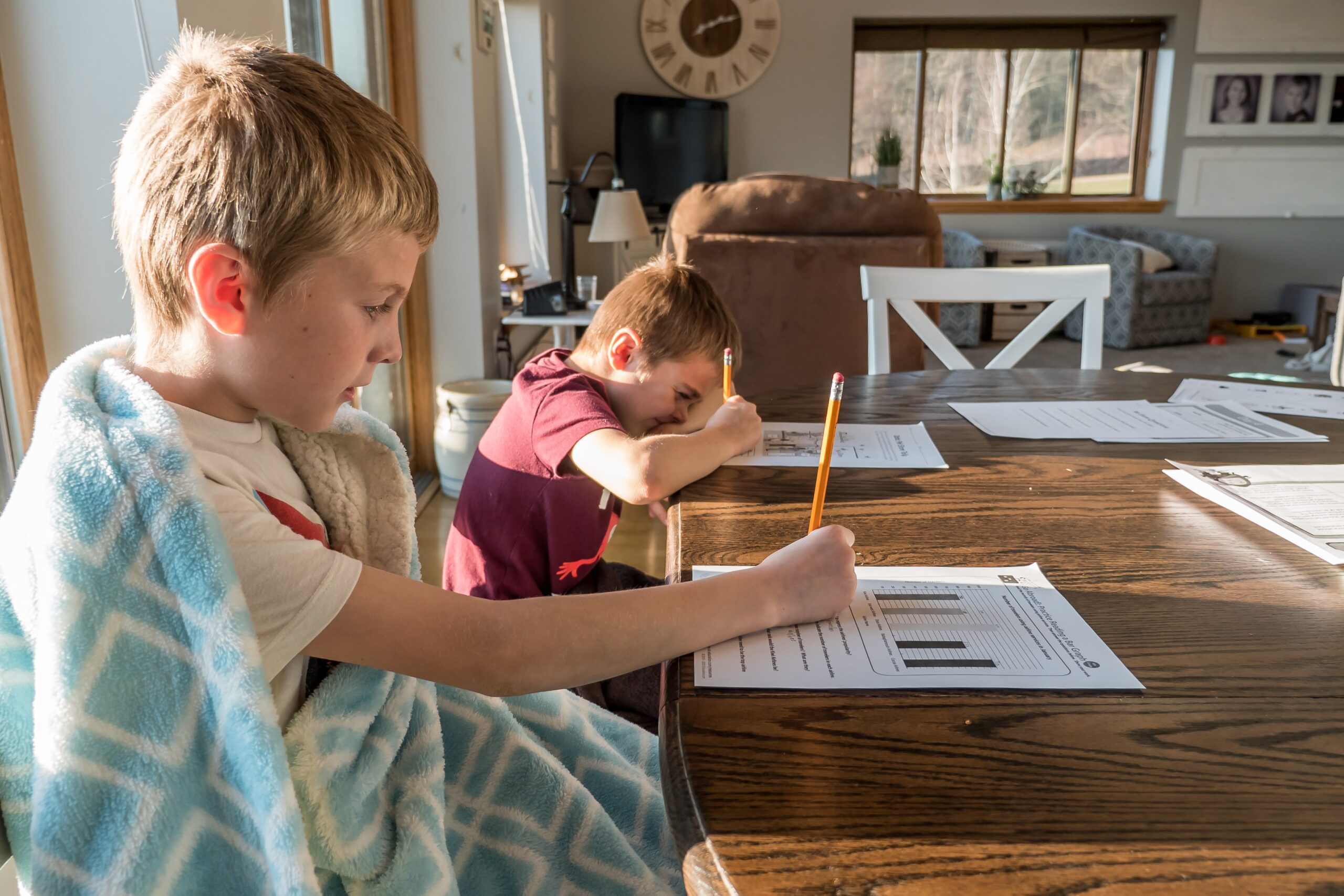
- The App
- Sandboxx News
- Resources
Learn
- Company
About
Become a Partner
Support
- The App
- Sandboxx News
- Resources
Learn
- Company
About
Become a Partner
Support
If you’re a parent, you’re probably quickly learning how to teach at home. You’re also probably Googling all the homeschooling tips you can find, right?...

If you’re a parent, you’re probably quickly learning how to teach at home.
You’re also probably Googling all the homeschooling tips you can find, right?
Since most parents aren’t teachers but still have to run a household and maybe even work remotely, this has been more than a challenge. Honestly, it’s been a big obstacle for many households.
From learning new technology to searching your memory files for algebraic formulas, you may be feeling a bit robotic getting through the day trying to parent and teach your kids.
You’re also likely realizing that teachers — like service members — all deserve fat paychecks and Bentleys.
While we can’t give you or the teachers in your life that, we can offer up some valuable homeschooling tips and resources on how to thrive and survive teaching your child(ren) at home.
Below we’ve included a roundup of tips and resources to assist in your teaching at home balancing act as a military family:

You’re not alone in playing teacher. You’re also not alone in the fact that you really remember why school is a place to send your offspring for several hours each day.
But here we are. Along with most of the world, in fact.
Right now, 91% of the world’s student population is dealing with school closures, according to UNESCO. If the last few weeks have been a struggle, perhaps a mindset shift and some new tools in your teaching at home arsenal will help.
Here are a few things to remember in these last few months of schooling your kiddos at home, no matter what their age:
If you haven’t been on a schedule, the time has come. While there’s no need to time every second of every day, it helps kids to know what to expect. Set the expectation for your little ones. Older kids (ages five and up) can help you create a schedule.
A few ways to do this:
Whether you set an Alexa timer or have your kids watch the clocks themselves, switch tasks as needed to get homework, activities, etc. done. Structure will make the day fly by and hold everyone to a standard of education that can also be found in classrooms.
Transitioning away from school to home learning is tough on everyone, especially your child. Think about how their routines have been shaken up and try to adjust your expectations to their reactions and any regressions based on that.
Setting expectations may look like:
As soon as you can, talk about expectations and any learning concerns to have a better understanding of points that might become power struggles.
If your child has specific coursework they need to complete, then you will want them to take care of that first, of course. But if you have time to weave fun into their day, it’ll make learning a lot easier. Consider baking for fractions lessons, nature walks for science exploration, and quiet time for reading new genres.
A few ways to incorporate fun:
Consider the fact that the world we live in is our greatest classroom. As the “teacher,” you can lead the way in exploration!
If you and your partner are working from home, it can be challenging to balance everyone’s needs. Consider setting a schedule for which parent steps in for parent/tutor time while the other parent works. One way to get into a good swing of things, including flexibility, is understanding everyone’s peak productivity time is different. Work with it, not against it.
Building flexibility may include:
Watch where your child(ren) struggles during the day. If math is a hard subject for them, consider letting them dive into math lessons first thing in the morning when they’re fresh. On another note, if your child(ren) needs a little extra guidance on homework, do what you can to assist them. Consider setting aside specific time in the evening to help your child check their work or go over any assignments.
Social distancing is the new norm. But it’s not normal for your kids as they need social interaction to thrive socially, emotionally, and educationally. Think of ways to virtually connect with other individuals like grandparents, family friends, and your child’s friends.
Consider connecting by:
If your spouse is deployed, letter writing is a great way to stay connected. If you’re too busy (and don’t want to go to the post office), our app is a great way to do it. Or, old-fashioned letters work, too. Check out our post Letter Writing For Kids: Letters Ideas to Send a Deployed Parent.
Try as you might, your home will never be school. It’s a place of comfort and relaxation, and it will never look the same to your child as their school. Plus, they aren’t surrounded by all their friends in school, but instead their pets, parents, or siblings. Keep it as a more organic learning experience and do your best to inspire their learning in a fun way.
Instead:
One thing you do want to replicate: A balance of indoor and outdoor time. Kids need fresh air and a place to burn off energy. Plus, it’s good for everyone’s physical and mental health to get outside for unstructured play time — no matter what their age.
It’s perfectly okay to ask for assistance. You aren’t normally sitting in your child’s classroom day in and day out, so it’s to be expected that you might feel a little disconnect. That’s what your child(ren)’s teacher and teacher aides are there for.
For extra help you may want to call on:
There’s no need to be embarrassed if you need some help navigating the new technology or classroom concepts. Reach out now to your child(ren)’s school if you’re struggling with balancing the education side of things.

The beauty of being able to teach your kids at home and online is the bountiful amount of resources you have at your fingertips. Whether your child(ren) needs extra training in math, science, English, or another topic, you can find a site to help. From Ivy League schools to online learning centers, the educational resource pool has never been larger.
Here’s a huge list of resources — many are free or have free trials — to supplement any resources your child(ren)’s school may have provided.

ABC Mouse – This site offers online curriculum for math, science, reading, art and colors for kids ages 2-8. There’s also an advanced learning course for kids 8-13 called Adventure Academy.
Bedtime Math – Not a fan of too much screen time? This site offers ideas for off-screen activities to engage kids in learning numeracy. It’s aimed at kids aged 3-9. There are also iOS and Android apps.
Hit the Button – For kids ages 6-11, this site offers interactive math games with quick-fire questions. It covers everything from number bonds to multiplying and dividing.
Buzzmath – Free until July 1, this interactive math platform is for students in K-12. There are 7,000+ activities built around Common Core Standards.

Scholastic Learn at Home program – Get 20 days’ worth of activities to reinforce educational principles while your child is out of school. Activities are available for PreK through ninth grade. The Scholastic site has a variety of books on sale for all ages and provides recommended book lists, too.
Oxford Owl – Get free access to eBooks and resources through this website. There are also math and kids’ activity sheets you can get through the site as well.
Your local library – While your local branch may be closed, if you have a library card, you have access to all the materials and eBooks online. Check out your county library’s resources. Some do a weekly story time and others provide access to research databases for older students.
Epic! – Try this online library for free for 30 days. You’ll have instant access to 40,000 quizzes, digital books, learning videos, and more for kids of all ages. Cancel your membership at any time.
Khan Academy – This site offers free online courses, lessons, and practice exercises. During the current school closures due to COVID-19, you can get daily lessons for ages 2 through 18, along with remote learning resources. You’ll find special content on here from NASA and The Museum of Modern Art, too.
Fivable – This is an online community for Advanced Placement (AP) students to learn together. It’s free and allows students to join in on live streams for topics like rhetorical analysis, cell communication and cell cycles, civil rights, and more. It provides weekly games and resources — all free.
Need an extra challenge for your too-smart-for-school teenager? Ask them to pick from one of thousands of free online courses from top Ivy League schools like Harvard and MIT. Class Central offers courses in everything from data science and business to humanities and personal development.
No one saw this COVID-19 crisis coming. Parents like yourself certainly didn’t see working from home paired with becoming overnight teachers, either.
And while you may be your child’s first teacher, it’s definitely a different ballgame to be teaching several subjects to your child all at once. Recognize and accept that it’s challenging to try and do your own work (household or otherwise) and learn new subjects on the fly.
All you can do is your best.
Use your child’s teachers, the above resources, and your own knowledge to navigate through this. Like everything else in life, it’s a season. A tough one, but it will end. However long your child has school for, just remember that there’s an equal amount of resources out there to get you through it together.
Since the COVID-19 pandemic is a rapidly changing situation, be sure to stay in touch with your child(ren)’s school for additional news on reopening dates. For military community schools, visit the DoDEA site for the latest updates.
To keep up with military community news, consider subscribing to Sandboxx News for the latest updates on family resources, military policy changes, and more.
Feature image courtesy of Unsplash




